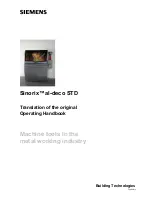
General safety instructions for
power tools
WARNING!
Read all the warnings and safety
instructions carefully.
Failure to follow the
warnings and safety instructions may result
in electric shock, fire and/or serious injuries.
Retain all the warnings and safety
instructions for future reference.
The term "power tool" in the safety
instructions refers to your mains-operated
(corded) power tool or battery-operated
(cordless) power tool.
1) Work area safety
a) Keep your work area clean and well lit.
Disorderly or inadequately lit work areas
can lead to accidents.
b)
Do not work with the power tool in
potentially explosive atmospheres
containing flammable liquids, gases or
dusts.
Power tools create sparks which
may ignite the dust or fumes.
c)
Keep children and other people out of
the area when operating the power tool.
Distractions can cause you to lose control
of the power tool.
2)
Electrical safety
a)
The power tool's mains plug has to
fit the socket. The plug should not
be modified in any way. Do not use
any adapter plugs with the earthed
(grounded) power tools.
Unmodified
plugs and matching sockets will reduce
risk of electric shock.
b)
Avoid bodily contact with earthed
objects such as pipes, radiators, ovens
and refrigerators.
There is an increased
risk of electric shock when your body is
earthed.
c)
Keep power tools out of rain and wet
environments.
Water entering a power
tool will increase the risk of electric
shock.
d)
Do not use the power cord for purposes
for which it is not intended, such as
carrying or hanging up the power tool,
and do not pull the cord to disconnect
the tool from the mains. Keep the power
cord away from heat, oil, sharp edges
or moving parts.
Damaged or entangled
power cords increase the risk of electric
shock.
e)
When operating the power tool
outdoors, use only extension cords
suitable for outdoor use.
Using an
extension cord suitable for outdoor use
reduces the risk of electric shock.
f)
If you need to use the power tool in
a damp environment, use a residual
current protection device.
Using a
residual current protection device reduces
the risk of electric shock.
3)
Personal safety
a)
Stay alert, watch what you are doing
and use common sense when operating
a power tool. Do not use a power
tool while you are tired or under
the influence of drugs, alcohol or
medication.
A moment of inattention
while operating power tools may result in
serious injury.
b)
Wear personal protective equipment and
always use safety goggles.
Protective
equipment such as dust mask, non-
skid safety shoes, hard hat, or hearing
protection used for appropriate conditions
will reduce personal injuries.
c)
Prevent unintentional start-up. Ensure
the switch is in the off-position before
connecting to power source and/or
battery pack, picking up or carrying the
tool.
Carrying power tools with your finger
on the switch or connecting it to the
mains with the switch in on-position, may
result in accidents.
d)
Remove any adjusting tools or keys
before you switch the power tool on.
A


































